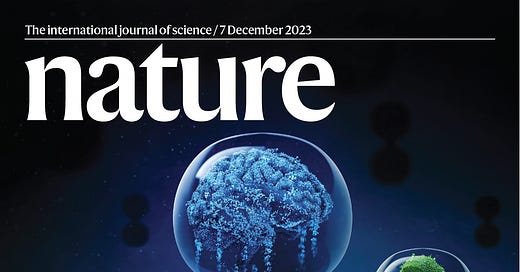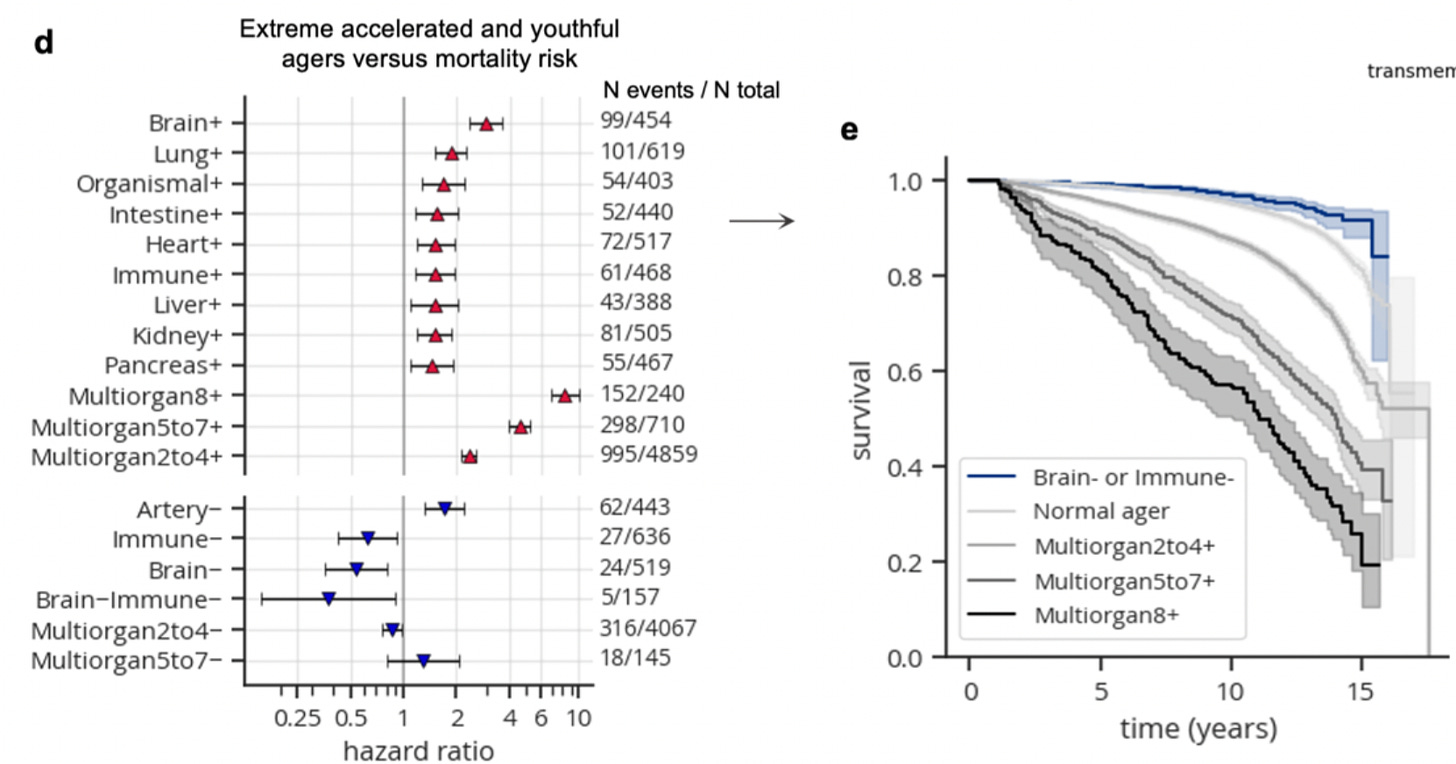The Emergence of Protein Organ Clocks
Predicting and Tracking Organ-Specific Aging, Health and Disease
Late last year, I interviewed Tony Wyss-Coray of Stanford University, who is doing pioneering work with an international team on proteomic organ clocks. His seminal paper, which prompted our conversation, was on the cover (below) at Nature. Since that publication there have been 2 new organ clock preprints based on the UK Biobank resource, the most recent one by Tony and his collaborators. In this edition of Ground Truths, I’m going to briefly review all 3 reports and explain why I think this will be one of the most important advances for tracking health and disease for the future.
The First Study
From 5 cohorts (3 healthy, 2 with Alzheimer’s disease) involving nearly 6,000 people, 11 organs were assessed with nearly 5,000 plasma proteins. (Figure)
About 1 in 5 individuals were an “extreme ager” for at least 1 organ, but only 2% had accelerated aging for multiple organs. The accelerated heart agers were 5-fold more likely to develop heart failure, the brain agers to more likely to manifest Alzheimer’s disease, muscle aging predicted gait impairment, and kidney aging predicted metabolic syndrome and high blood pressure. The gap between a person’s chronological age and organ age was associated with increased mortality during 15-year follow-up. For each increment of heart age of 4 years there was a 2.5 fold increase in risk of heart failure during the 15-year follow-up. The term FIBA in the above Figure refers to an algorithm-Feature Importance for Biological Aging, which predicted the arc of transition from normal cognition to mild cognitive impairment.
Below is the relationship between organ aging and mortality risk during 15-year follow-up [point estimates (circles) and 95% confidence intervals (bars)].
This work adds a new dimension to understanding human aging. While we knew there was variability in gaps between chronological age and biologic age at the whole-body level between people, the evidence here for organ-specific gaps within a person is compelling.
The Second Study
This work is from Vadim Gladyshev and colleagues from Harvard Medical School and the Broad Institute. Using data from the UK Biobank resource from about 53,000 participants, with measurement of 3,000 plasma proteins, 7 organ-specific aging clocks were confirmed, along with their relationship to clinical sequelae.
Below is a comparison of the organ-specific model predictions in this study versus the first one (Oh et al), with higher odds ratio for mortality. They are consistent in directionality but higher in magnitude for the 7 organs assessed in the previous study. Also a comparison with DNA methylation (GrimAge) for conventional (body-wide aging) is seen. Men had accelerated biological aging compared with women.
By looking at various interventions, this work (in preprint form) extended the first study. For example, it showed the association with smoking and alcohol with organ-specific aging (Figure).
They also looked at effect of many foods, medications, and occupations, Below are the data for foods showing which ones were associated with favorable organ-specific effects (top, blue) and unfavorable impact (bottom).
The Third Study
We’re back to Tony Wyss-Corsay and colleagues with a recent preprint of their study of 44,000 UK Biobank participants, 3,000 plasma proteins, for 11 organ-specific clocks. This work fully replicated their earlier publication but again there were a notable extension of findings.
For example, the potential benefit of hormone replacement (or unfavorable impact of menopause) for delaying organ-specific biological aging.(N.B. These again are associations, not established cause and effect).
Seen below is the relationship of various interventions including smoking, alcohol, moderate or vigorous exercise, foods on organ-specific age gaps.
Perhaps the most interesting finding is the prominent organ aging associated with improved survival—the brain, and young brain or immune system individuals (right panel).
Significance
These 3 organ-specific aging reports are noteworthy for many reasons. We’re in an era when thousands of plasma proteins can be measured in an individual and A.I. models can be developed to understand the relationship of key protein clusters with organ aging. All 3 of the studies reviewed here used the SomaScan platform (SomaLogic company) or OLink platform (ThermoFisher). The findings are now replicated across multiple cohorts and by independent researchers. Other high-throughput proteomic studies are also showing the ability to predict future dementia, hip fractures, and various other conditions. Increasingly, they are seen to be complementary or supersede polygenic risk scores for predictive accuracy.
Unlike interventions in the mouse and other animal models, we are learning how difficult it is to slow body-wide aging in people. A far more realistic objective would be to slow the biological aging process in a particular organ in people who are extreme agers.
Moreover, plasma proteins could be used to help identify individuals at high-risk of organ-specific disease. With early implementation of risk reduction that disease may be prevented or markedly delayed. The organ clock sensitivity to various interventions like alcohol, exercise, hormonal replacement and diet may, on serial assessment, provide unique insights at both the population and individual levels. Beyond all these contributions, the studies have been identifying particular proteins that link with the human organ-specific aging process. These findings may serve as leads or templates for drug discovery efforts in the future.
In sum, this is a remarkable series of three reports with considerable promise to revamp our assessment of health and disease in the future. It adds significantly to the medical forecasting capabilities—at the individual level— for age-related diseases that I recently wrote about in Science.
*********************************************************
Thanks for reading and subscribing to Ground Truths. All content of these newsletter/analyses and podcasts are free, with no advertisements.
Please share this post, especially if you found it interesting or informative.
If you do elect to be a paid subscriber, all proceeds are donated to Scripps Research and such support has already been extremely helpful for our summer internship programs and other educational activities. Comments and questions from paid subscribers are welcome.












